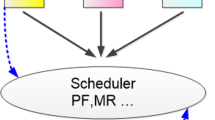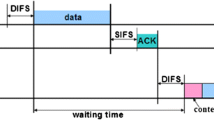Abstract
In network with a shared channel in TDMA mechanism, it is a core issue to effectively allocate channel time to provide service guarantees for flows with QoS requirements. This paper proposes a simple and efficient time allocation scheme called MES-ESRPT (MCTA at the End of Superframe-Enhanced Shortest Remaining Processing Time) for delay-sensitive VBR traffic in accordance with IEEE 802.15.3 standard. In this algorithm, PNC (piconet coordinator) allocates one MCTA (Management Channel Time Allocation) for each stream which is the process of communication at the end of superframe. During the MCTA period, each transmitter should report current fragments number of the first MSDU (MAC Service Data Unit) and the fragments number of the remainder MSDUs to PNC. In the next superframe, PNC firstly allocates part CTAs (Channel Time Allocation) for each stream based on the remainder fragments number of the first MSDU by SRPT rule, then allocates remainder CTAs for each stream based on all fragments number of remainder MSDUs by the same SRPT rule. Simulation results showed that our proposed MES-ESRPT method achieves significantly better performance in QoS for multimedia streams compared to the existing schemes.
Similar content being viewed by others
References
Draft P802.15.3/D17, 2003. Draft Standard for Telecommunications and Information Exchange between Systems—LAN/MAN Specific Requirements, Part 15.3: Wireless Medium Access Control (MAC) and Physical Layer (PHY) Specifications for High Rate Wireless Personal Area Networks (WPAN).
Goldsmith, A., Varaiya, P., 1986. Capacity of fading channels with channel side information. IEEE Transactions on Information Theory, 43(6):1924–1934.
Knopp, R., Humblet, P., 1995. Information Capacity and Power Control in Single-Cell Multi-User Communications. Proc. IEEE International Conference on Communications (ICC’95). Seattle, USA.
Mangharam, R., Demirhan, M., Rajkumar, R., Raychaudhuri, D., 2004. Size Matters: Size-based Scheduling for MPEG-4 over Wireless Channels. SPIE Conference on Multimedia Computing and Networking.
Tsang, T.K.K., El-Gamal, M.N., 2005. Ultra-Wideband (UWB) Communications Systems: An Overview. The 3rd International IEEE-NEWCAS Conference, p.124–129.
Viswanath, P., Tse, D., Laroia, R., 2002. Opportunistic beam-forming using dumb antennas. IEEE Transactions on Information Theory, 48(6):1277–1294. [doi:10.1109/TIT.2002.1003822]
Wang, H.S., Chang, P., 1994. On Verifying the First-order Markovian Assumption for a Rayleigh Fading Channel Model. Third Annual International Conference, p.160–164.
Zorzi, M., Rao, R.R., Milstein, L.B., 1995. On the Accuracy of a First-order Markov Model for Data Transmission on Fading Channels. Fourth IEEE International Conference, p.211–215.
Author information
Authors and Affiliations
Additional information
Project supported by the National Natural Science Foundation of China (No. 60432030) and Distinguished Young Scholars of the Natural Science Foundation of China (No. 60525111)
Rights and permissions
About this article
Cite this article
Liu, X., Dai, Qh. & Wu, Qf. Time allocation scheme in IEEE 802.15.3 TDMA mechanism. J. Zhejiang Univ. - Sci. A 7 (Suppl 1), 159–164 (2006). https://doi.org/10.1631/jzus.2006.AS0159
Received:
Accepted:
Published:
Issue Date:
DOI: https://doi.org/10.1631/jzus.2006.AS0159




